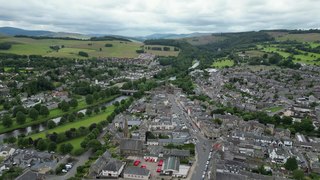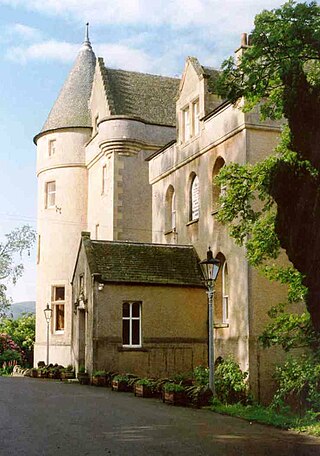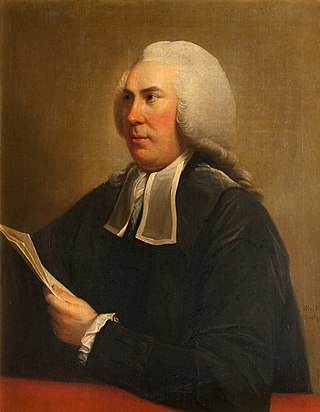
Peebles is a town in the Scottish Borders, Scotland. It was historically a royal burgh and the county town of Peeblesshire. According to the 2011 census, the population was 8,376 and the estimated population in June 2018 was 9,000.

Peeblesshire, the County of Peebles or Tweeddale is a historic county of Scotland. Its county town is Peebles, and it borders Midlothian to the north, Selkirkshire to the east, Dumfriesshire to the south, and Lanarkshire to the west.

Sir James Montgomery, 1st Baronet Stanhope, FRSE was a Scottish advocate, judge, country landowner, agriculturalist and politician who sat in the House of Commons from 1766 to 1775. In 1783 he was a joint founder of the Royal Society of Edinburgh.

Broughton is a village in Tweeddale in the historical county of Peeblesshire in the Scottish Borders council area, in the south of Scotland, in the civil parish of Broughton, Glenholm and Kilbucho and Upper Tweed Community Council. Broughton is on the Biggar Water, near where it flows into the River Tweed. It is about 7 km east of Biggar, and 15 km west of Peebles.

Comlongon Castle is a tower house dating from the later 15th century or early 16th century. It is located 1 kilometre (0.62 mi) west of the village of Clarencefield, and 10 kilometres (6.2 mi) south-east of Dumfries, in south west Scotland. The original tower has been extended by the addition of a baronial style mansion, completed around 1900. Originally built by the Murrays of Cockpool, it remained in the Murray family until 1984. It was subsequently restored, having been vacant for some time, and the castle and mansion are now a hotel. As of 15 April 2019, the business side of Comlongon Castle has gone into Administration, consequently all weddings due and accommodation booked for after this date were cancelled, leaving the future of the castle uncertain.

Yester Castle is a ruined castle, located 1+1⁄2 miles southeast of the village of Gifford in East Lothian, Scotland. The only remaining complete structure is the subterranean Goblin Ha' or Hobgoblin Ha' . It is a Scheduled Ancient Monument, recorded as such by the Royal Commission on the Ancient and Historical Monuments of Scotland.

Ochtertyre is a country house and estate in Perth and Kinross, Scotland. It is located in Strathearn, between Crieff and Loch Turret, north of the A85.

Eddleston is a small village and civil parish in the Scottish Borders area of Scotland. It lies 4 miles (6.4 km) north of Peebles and 9 miles (14 km) south of Penicuik on the A703, which passes through the centre of the village. Nearby is the Great Polish Map of Scotland, a large terrain map. The Eddleston Water runs through the village.

Craigiehall is a late-17th-century country house, which until 2015 served as the Headquarters of the British Army in Scotland. It is located close to Cramond, around 9 km (5.6 mi) west of central Edinburgh, Scotland.

Venlaw Castle, also known as Smithfield Castle, lies north of Peebles on the Edinburgh Road in the Borders of Scotland. Since 1949, it has been operated as a hotel. It was designated in 1971 as a Category A listed building.

The Chambers Institution is a municipal structure in the High Street in Peebles, Scotland. The structure, which was designed to accommodate a library, a museum, an art gallery and Peebles Burgh Hall, is a Category A listed building.

Cringletie is a Scottish Baronial house by the Eddleston Water, around 3 kilometres (1.9 mi) south of Eddleston in the Scottish Borders area of Scotland, in the former Peeblesshire. Designed by David Bryce and built in 1861, the house is a Category B listed building. Since 1971 it has been operated as a country house hotel.
Darnhall Mains is a farm and settlement off the A703, near Eddleston and the Eddleston Water in the Scottish Borders area of Scotland, in the former Peeblesshire.

Stobo Castle is located at Stobo in the Scottish Borders, in the former county of Peeblesshire. The Manor of Stobo was originally owned by the Balfour family. It became the family seat of the Graham-Montgomery Baronets from 1767. The building of the present castle began in 1805 and was completed in 1811 under the supervision of architects Archibald and James Elliot. It is currently operated as a health spa. The house is protected as a category A listed building, while the grounds are included in the Inventory of Gardens and Designed Landscapes in Scotland, the national listing of significant parks and gardens.

The Great Polish Map of Scotland is a large three-dimensional, outdoor concrete scale model of Scotland, located in the grounds of the Barony Castle Hotel, outside the village of Eddleston near Peebles in the Scottish Borders. It is also known as the Mapa Scotland or the Barony Map. The brainchild of Polish war veteran Jan Tomasik, it was built between 1974 and 1979 and is claimed to be the world's largest terrain relief model. The sculpture is a category B listed building, and has been restored by a group calling itself Mapa Scotland.

Blackhall Manor is a tower house in Paisley in Renfrewshire, in the western central Lowlands of Scotland. It dates to the sixteenth century, although parts may be older, and formerly belonged to the Stewart or Shaw-Stewart family. It was designated as a Category B listed building in 1971.

Penicuik House survives as the shell of a formerly grand estate house in Penicuik, Midlothian, Scotland. The 18th-century palladian mansion was built on the site of an earlier house by Sir James Clerk, 3rd Baronet. It was destroyed by fire in 1899 and a major restoration, stabilising the ruin, was completed in 2014 by G Brown Stonemasons.

Alexander Murray, Lord Henderland was a Scottish judge and politician.

Westgate Hall is located in Westgate in the village of Denholm, Roxburghshire, in the Scottish Borders. It stands at the western and south-western approaches to the village. Dating from the 17th century, it is an example of a building of that period that was once common in Scotland and is now a category A listed building.

The Barony of Stobo is a Scottish feudal barony which takes its name from Stobo in the Scottish Borders.


















